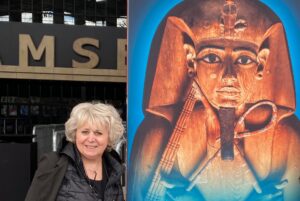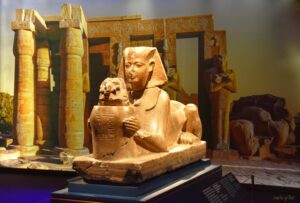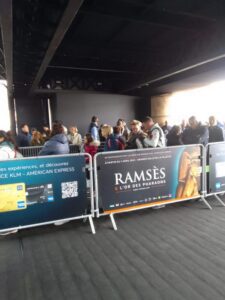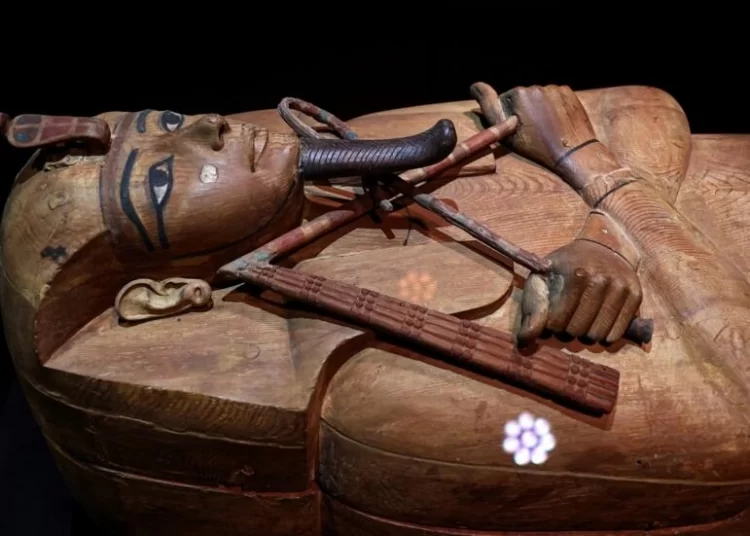On March 23, King Ramses II’s sarcophagus left the National Museum of Egyptian Civilisation in Fustat and took an Air France passenger flight to Paris for a temporary visit to boost tourism.
It left Cairo to be a centrepiece of a temporary exhibition entitled ‘Ramses the Great and the Gold of the Pharaohs’ at the Grande Halle de la Villette in the French capital.
“When you arrive at La Grande Halle de La Villette, you leave Paris ‘definitively’ to experience privileged moments in the heart of Egypt and its rich past,” Marie Grillot, membre de la Mission Archéologique Française de Thèbes-Ouest, told The Egyptian Gazette from the French capital.

Ramses II (1279-1213 BC) was the third ruler of the Nineteenth Dynasty. He is considered one of the greatest warrior pharaohs in the era of the New Kingdom. He ruled Egypt for 66 years, and was an important military leader known for his extensive building and colossal statues of him found all over Egypt.
The sarcophagus has great status as it was discovered in the cache of Deir el-Bahari in 1881. It is made of cedar wood and painted yellow. It represents the “king in human form” with his hands crossed, holding the insignia of government, a sceptre and a whip, and he has a braided false beard.
“We are close to Ramses II who ruled for 66 years… Faced with this long history, the one that links it to France may seem thin… but it exists very intimately,” Grillot said.
It is not the first time that Ramses II has visited France. He was there 47 years ago.
“He indeed came to us in person on September 26, 1976, precisely. His mummy was welcomed like a head of state… it stayed until May 10, 1977, to be treated and cured… At the same time, at the Grand Palais the exhibition ‘Ramses the Great’, from May 15 to October 15, 1976, by French Egyptologist Christiane Desroches Noblecourt. The exhibition received 1,200,000 visitors,” Grillot added.
On the other hand, she added, Ramses II is present in Paris, through the obelisk of his temple of Amun at Luxor.
“He was chosen with as much care as a determination by Jean-François Champollion during the Franco-Tuscan expedition of 1828-1829. Since its erection in Place de la Concorde on October 25, 1836, its solar presence has made Egypt shine in the heart of our capital,” Grillot said.
Since the opening of “Ramses the Great and the Gold of the Pharaohs” on April 7 at La Grande Halle de La Villette, the exhibition has witnessed a great turnout of visitors.
Secretary-General of the Supreme Council of Antiquities Mostafa Waziry told The Gazette that before its official opening, 145,000 tickets were sold online. It is expected that the number of visitors will reach one million.
The exhibition, except for the sarcophagus, is in its third stop after it was displayed at Houston Museum and San Francisco. Each stop was for six months.
Waziry added that the exhibition in Houston Museum received 350,000 visitors and in de Young, Herbst Exhibition Galleries in San Francisco, it welcomed more than 400,000 visitors.
“The French media are covering extensively the exhibition and its artefacts, which is a good way for promoting Egyptian tourism abroad,” he said.
The opening ceremony was attended by Waziry, Minister of Tourism and Antiquities Ahmed Issa, Egyptian Ambassador to France Alaa Youssef, famous archaeologist Zahi Hawass, and former Minister of Tourism and Antiquities Khaled al-Anani, who was nominated this month for the post of UNESCO director-general during the period between 2025 and 2029.
The exhibition, which runs until September 6, includes 181 unique artefacts that show some of the holdings of the Egyptian Museum in Tahrir dating back to the era of King Ramses II, some artefacts from the discoveries of the Egyptian mission in the Bubasteum area in Saqqara.
In addition to artefacts from the Middle, Modern, New and Late New Kingdoms such as statues, ornaments, cosmetics, paintings, stone blocks decorated with inscriptions, and statues of deities in the form of birds and animals, in addition to some coloured wooden coffins.
The Ramses II sarcophagus is displayed for the first time outside Egypt in the exhibition, in appreciation of the role of French archaeologists in providing assistance and support in the restoration and treatment of the mummy of King Ramesses II in 1976 from fungi.
The exhibition allows visitors who are already fans of the ancient Egyptian civilisation to experience the discovery of Abu Simbel Temple of Ramses II, on the western bank of Lake Nasser, about 230 km southwest of Aswan and the tomb of Nefertari, the Great Royal Wife of Ramses II, through virtual reality technology.
The exhibition also displays a set of videos that tell the history of King Ramses II and the war battles he led, such as the Battle of Kadesh which took place between the forces of the New Kingdom of Egypt and the Hittite Empire.
La Grande Halle de La Villette has previously hosted an exhibition entitled ‘Tutankhamun – Treasures of the Golden Pharaoh’ from 23 March to 22 September 2019. It received 1.4 million visitors.
“And beyond all that, Ramses II is eternity… By his stone temples which recount his glorious deeds, by his deified colossi, by his sandstone or granite statues with stretched eyes and marvellous smiles, by his mummy, he is immortal,” Grillot said.














Discussion about this post